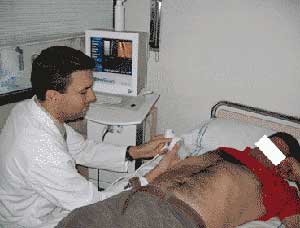If diagnosed in the early stages when the liver is mildly fibrotic, the chances of recovery are high. This is also the reason why the Medical Diagnostic Center (MEDIC) invested $112,000 in a Fibroscan machine. This device allows for early diagnosis without harming the patient.
 |
| Diagnosing liver disease with Fibroscan. (Photo: medscape) |
Dr. Phan Thanh Hải, the director of the Medical Diagnostic Center, stated: “The demand for diagnosis without causing harm to the body is always a consumer wish.”
The Five Stages of Liver Hardness
The diagnostic process is similar to an ultrasound; the doctor will use a probe to scan the right hypochondrium within a few minutes. The result will provide the patient with a single number called Kpa (kiloPascal). This unit indicates the hardness of the liver corresponding to the number of fibrotic cells, ranging from 1 to 75, divided into five stages: F0 normal, F1 mild fibrosis, F2 moderate fibrosis, F3 severe fibrosis, and F4 advanced fibrosis. However, this technique does have limitations, as it cannot “see” the livers of obese individuals or those with excessive subcutaneous fat or ascites.
Detecting Disease
Ms. Phạm Thị Bạch Tuyết, 51, an employee at a printing company in Ho Chi Minh City, after undergoing a routine health check, requested a blood test for vaccinations. The blood test results indicated hepatitis B infection. She noted that the liver diagnostic results showed moderate fibrosis, and with active treatment, recovery is possible.
Unfortunately, unlike Ms. Tuyết, Mr. T.B.H, 62, residing in District 3, suffers from cirrhosis. He mentioned: “The doctors suggested a CT scan, but due to the high costs, I decided to check my liver first.” The result: 22.1 Kpa – indicating severe cirrhosis and a tumor appeared on the screen. According to Dr. Lê Đình Vĩnh Phúc from the Medical Diagnostic Center: “A tumor found on the background of cirrhosis should not be assumed to be benign; further CT examinations are necessary for timely treatment.”
Cirrhosis is mostly caused by alcohol consumption, but we were surprised when Mr. H. stated he hasn’t consumed alcohol for 31 years. Without drinking alcohol or beer and still being ill, we inquired further about his reasons for abstaining. He confessed that in the past, he would drink half a liter at meals, but after 8 PM, he would celebrate with friends by drinking large bottles. One day, after having just a small glass, he fainted, felt uncomfortable, and could no longer drink, which led him to stop!
Phương Nam
|
* According to statistics from the Liver Association, 15% of the population suffers from chronic hepatitis B, and 6% from chronic hepatitis C. There are increasing risks to liver health from alcohol, drugs, food, mold, etc. Hospitals face cases of cirrhosis and late-stage liver cancer every year. * This technique does not replace standard color ultrasound, as color ultrasound can qualitatively determine liver conditions. However, this technique can substitute for biopsies to assess liver fibrosis status. * Worldwide, this machine is used in the European community, with a single examination covered by insurance costing 300 euros. This technique is widely used for individuals at risk and those who have previously consumed a lot of alcohol. In the U.S., three states use this machine and are awaiting FDA approval for widespread use. In Asia, three countries have equipped this machine: South Korea, Singapore, and China. MEDIC has been using it since April 2006. |


















































